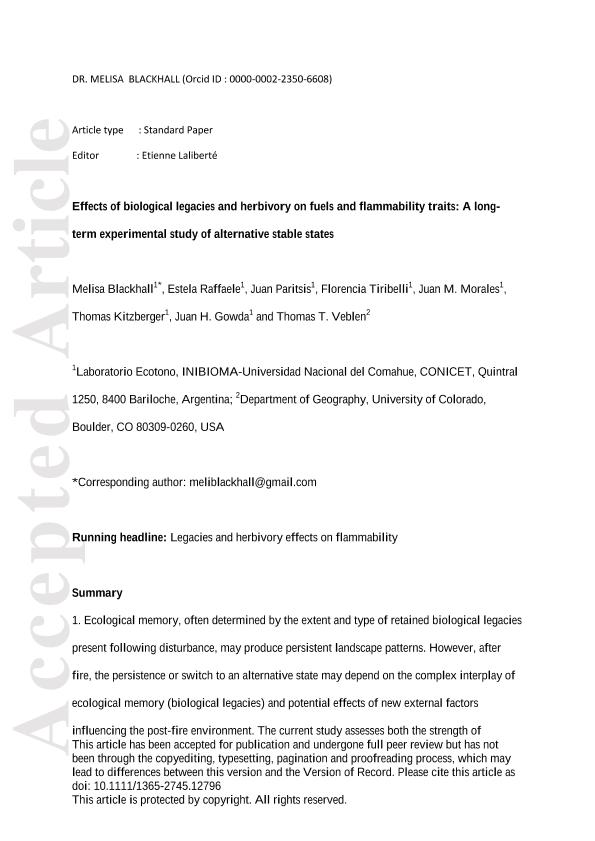Artículo
Effects of biological legacies and herbivory on fuels and flammability traits: A long-term experimental study of alternative stable states
Blackhall, Melisa ; Raffaele, Estela
; Raffaele, Estela ; Paritsis, Juan
; Paritsis, Juan ; Tiribelli, Florencia
; Tiribelli, Florencia ; Morales, Juan Manuel
; Morales, Juan Manuel ; Kitzberger, Thomas
; Kitzberger, Thomas ; Gowda, Juan Janakiram Haridas
; Gowda, Juan Janakiram Haridas ; Veblen, Thomas
; Veblen, Thomas
 ; Raffaele, Estela
; Raffaele, Estela ; Paritsis, Juan
; Paritsis, Juan ; Tiribelli, Florencia
; Tiribelli, Florencia ; Morales, Juan Manuel
; Morales, Juan Manuel ; Kitzberger, Thomas
; Kitzberger, Thomas ; Gowda, Juan Janakiram Haridas
; Gowda, Juan Janakiram Haridas ; Veblen, Thomas
; Veblen, Thomas
Fecha de publicación:
09/2017
Editorial:
Wiley Blackwell Publishing, Inc
Revista:
Journal of Ecology
ISSN:
0022-0477
Idioma:
Inglés
Tipo de recurso:
Artículo publicado
Clasificación temática:
Resumen
Ecological memory, often determined by the extent and type of retained biological legacies present following disturbance, may produce persistent landscape patterns. However, after fire, the persistence or switch to an alternative state may depend on the complex interplay of ecological memory (biological legacies) and potential effects of new external factors influencing the post-fire environment. The current study assesses both the strength of ecological memory resulting from biological legacies of pre-burn vegetation types as well as post-fire effects of livestock. Following a severe fire in 1999, we set up a network of long-term exclosures to examine the effects of legacies and cumulative herbivory by cattle on fuel types, amounts, distribution, flammability and microenvironmental conditions in two post-fire communities representing alternative fire-driven states: pyrophobic Nothofagus pumilio subalpine forests and pyrophytic Nothofagus antarctica tall shrublands in northwestern Patagonia, Argentina. Our results show that the retained post-disturbance legacies of tall shrublands and subalpine forests largely determine fuel and flammability traits of the post-fire plant communities 16 years after fire. The importance of biological legacies retained from the unburned plant communities was reflected by the substantially higher amounts of total fine fuel, greater vertical and horizontal fuel continuity and the higher temperatures reached during experimental tissue combustion at post-fire shrubland compared to post-fire forest sites. We show that herbivores may produce antagonistic effects on flammability by decreasing tissue ignitability, total fine fuel and litter depth, and disrupting the vertical and horizontal fine fuel continuity, therefore reducing the probability of fire propagation. However, cattle can increase ratios of dead to live fine fuels, reduce soil moisture, and inhibit tree height growth to canopy size, consequently impeding the development of a closed pyrophobic forest canopy. Synthesis. Our results support the hypothesis that biological legacies, most importantly the dominance by pyrophytic woody plants that resprout vigorously vs. the dominance by pyrophobic obligate seeders, favour fuel and flammability characteristics at the community level which reinforce the mechanisms maintaining pyrophytic shrublands vs. pyrophobic forests. Herbivory by introduced cattle can partially blur sharp pyrophobic/pyrophytic state boundaries by promoting the development of novel post-fire transitional states.
Archivos asociados
Licencia
Identificadores
Colecciones
Articulos(INIBIOMA)
Articulos de INST. DE INVEST.EN BIODIVERSIDAD Y MEDIOAMBIENTE
Articulos de INST. DE INVEST.EN BIODIVERSIDAD Y MEDIOAMBIENTE
Citación
Blackhall, Melisa; Raffaele, Estela; Paritsis, Juan; Tiribelli, Florencia; Morales, Juan Manuel; et al.; Effects of biological legacies and herbivory on fuels and flammability traits: A long-term experimental study of alternative stable states; Wiley Blackwell Publishing, Inc; Journal of Ecology; 105; 5; 9-2017; 1309-1322
Compartir
Altmétricas



